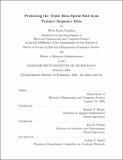| dc.contributor.advisor | Bonnie A. Berger and Roy E. Welsch. | en_US |
| dc.contributor.author | Scanlon, Eben Louis, 1974- | en_US |
| dc.contributor.other | Sloan School of Management. | en_US |
| dc.date.accessioned | 2005-05-17T14:41:13Z | |
| dc.date.available | 2005-05-17T14:41:13Z | |
| dc.date.copyright | 2004 | en_US |
| dc.date.issued | 2004 | en_US |
| dc.identifier.uri | http://hdl.handle.net/1721.1/16617 | |
| dc.description | Thesis (S.M.)--Massachusetts Institute of Technology, Dept. of Electrical Engineering and Computer Science; and, (M.B.A.)--Massachusetts Institute of Technology Sloan School of Management, 2004. | en_US |
| dc.description | Includes bibliographical references (leaves 118-125). | en_US |
| dc.description | This electronic version was submitted by the student author. The certified thesis is available in the Institute Archives and Special Collections. | en_US |
| dc.description.abstract | The Triple β-Spiral is a novel protein structure that plays a role in viral attachment and pathogenesis. At present, there are two Triple β-Spiral structures with solved crystallographic coordinates - one from Adenovirus and the other from Reovirus. There is evidence that the fold also occurs in Bacteriophage SF6. In this thesis, we present a computational analysis of the Triple β-Spiral fold. Our goal is to discover new instances of the fold in protein sequence databases. In Chapter 2, we present a series of sequence-based methods for the discovery of the fold. The final method in this Chapter is an iterative profile-based search that outperforms existing sequence-based algorithms. In Chapter 3, we introduce specific knowledge of the protein's structure into our prediction algorithms. Although this additional information does not improve the profile-based methods in Chapter 2, it does provide insight into the important forces that drive the Triple β-Spiral folding process. In Chapter 4, we employ logistic regression to integrate the score information from the previous Chapter into a single unified framework. This framework outperforms all previous methods in cross-validation tests. We do not discover a great number of additional instances of the Triple β-Spiral fold outside of the Adenovirus and Reovirus families. The results of our profile based templates and score integration tools, however, suggest that these methods might well succeed for other protein structures. | en_US |
| dc.description.statementofresponsibility | by Eben Louis Scanlon. | en_US |
| dc.format.extent | 125 leaves | en_US |
| dc.format.extent | 1405581 bytes | |
| dc.format.extent | 1405408 bytes | |
| dc.format.mimetype | application/pdf | |
| dc.format.mimetype | application/pdf | |
| dc.language.iso | eng | en_US |
| dc.publisher | Massachusetts Institute of Technology | en_US |
| dc.rights | M.I.T. theses are protected by copyright. They may be viewed from this source for any purpose, but reproduction or distribution in any format is prohibited without written permission. See provided URL for inquiries about permission. | en_US |
| dc.rights.uri | http://dspace.mit.edu/handle/1721.1/7582 | |
| dc.subject | Electrical Engineering and Computer Science. | en_US |
| dc.subject | Sloan School of Management. | en_US |
| dc.title | Predicting the triple beta-spiral fold from primary sequence data | en_US |
| dc.type | Thesis | en_US |
| dc.description.degree | M.B.A. | en_US |
| dc.description.degree | S.M. | en_US |
| dc.contributor.department | Massachusetts Institute of Technology. Department of Electrical Engineering and Computer Science | |
| dc.contributor.department | Sloan School of Management | |
| dc.identifier.oclc | 55676678 | en_US |
